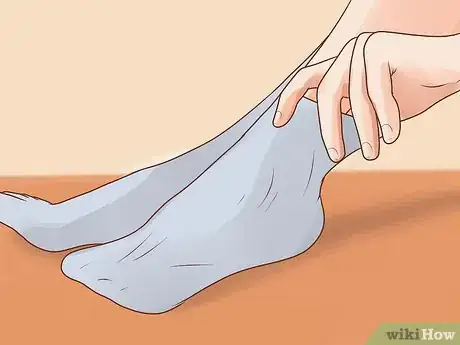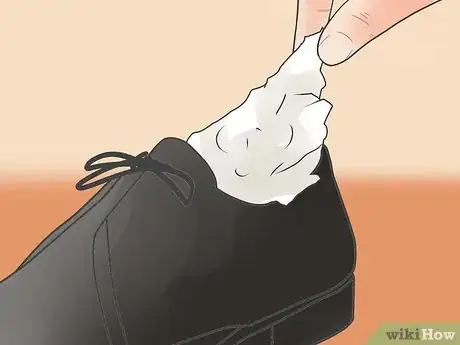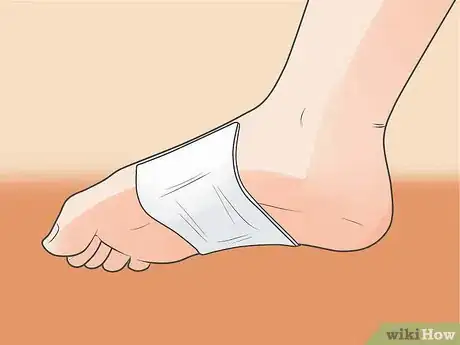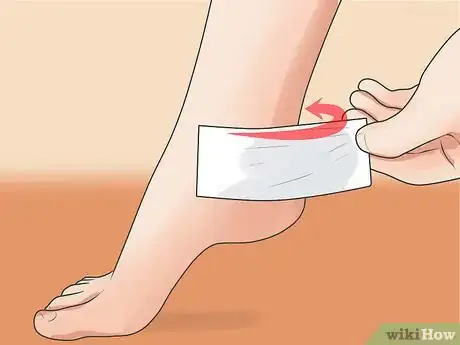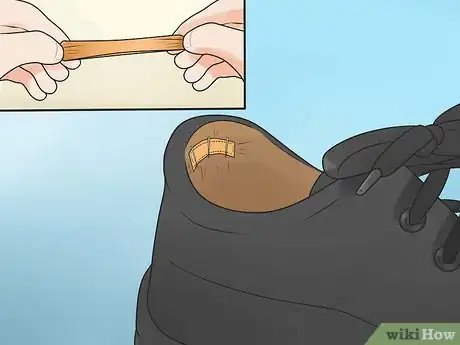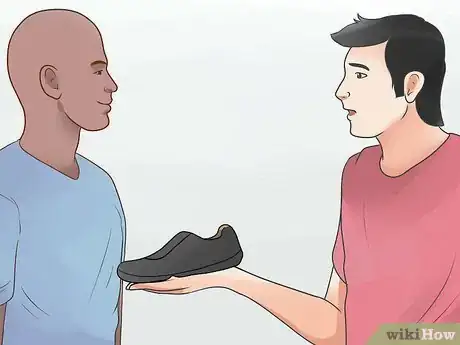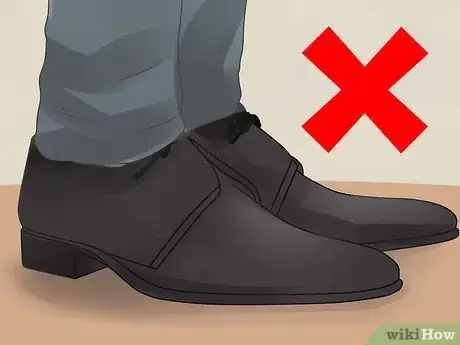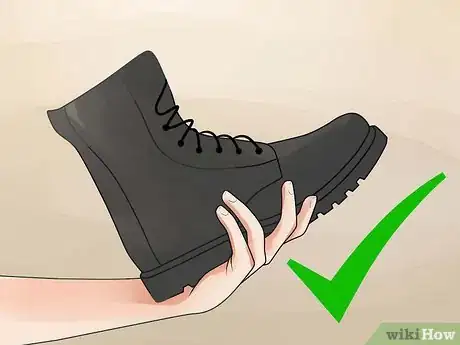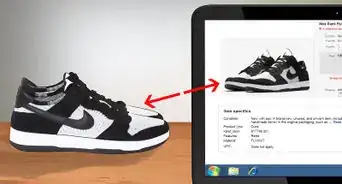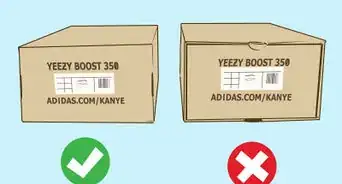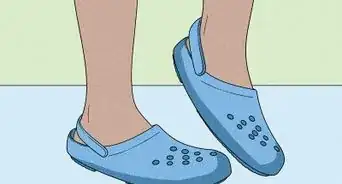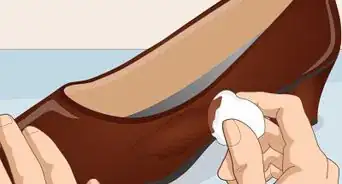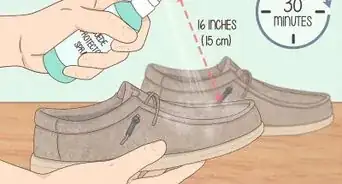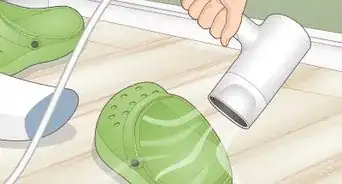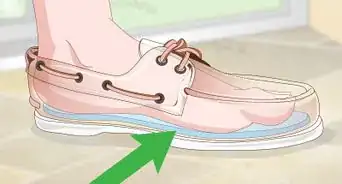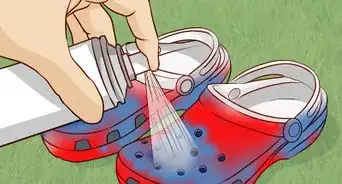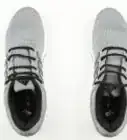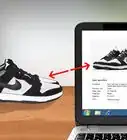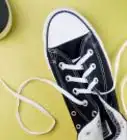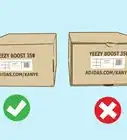This article was co-authored by Marc Sigal. Marc Sigal is the Founder of ButlerBox, a dry cleaning and shoe care service based in Los Angeles, California. ButlerBox places custom-designed, wrinkle-resistant lockers in luxury apartment buildings, class A office buildings, shopping centers, and other convenient locations so you can pick up and drop off items 24 hours a day, 7 days a week. Marc has a BA in Global and International Studies from the University of California, Santa Barbara.
wikiHow marks an article as reader-approved once it receives enough positive feedback. This article has 22 testimonials from our readers, earning it our reader-approved status.
This article has been viewed 2,519,915 times.
Everyone knows the feeling: you spot the perfect pair of shoes and go to try them on, but they’re just too big. Thankfully, whether they’re oversized in one specific area or just giant overall, there are plenty of tricks you can use to wear big shoes without looking silly.
Steps
Easier Methods
-
1Wear thicker socks (or multiple pairs). Perhaps the easiest thing you can do to make a loose pair of shoes fit better is to "bulk up" your feet with thicker layers of socks. For example, you might try exchanging a skin-tight pair of dress socks or tights for a padded set of crew socks. You can even wear two or three pairs of socks on top of each other — the thicker the padding, the more tightly your foot will sit in the shoe.
- Best for: Athletic shoes, boots.
- Notes: This can be an uncomfortable choice in hot weather, especially if you tend to get sweaty feet.
-
2Stuff the toes of your shoes. In a pinch, you can use cheap, wadded-up material (like cotton balls, tissue paper, toilet paper, or even thin rags) to fill in the space at the the tips of your shoes. This is a great choice if you feel your feet sliding from the fronts of your shoes to the back as you walk — plus, it's something you can do almost anywhere.
- Best for: Flats, boots, close-toed heels.
- Notes: Not a particularly good choice for athletic situations or long walks — the "filler" material can get gross and uncomfortable with heavy use.
Advertisement -
3Use an insole. An insole is a soft pad (usually made of foam or gel material) that sits under your foot in the shoe to provide cushioning and support. Insoles are often intended to help with posture problems and discomfort, but they're also handy for taking up extra space in shoes that are too loose. Insoles can be purchased for reasonably cheap at most places where shoes are also sold.
- Best for: Most shoes (including heels and open-toed shoes).
- Notes: If you can, try on any insoles before buying to make sure they are comfortable to wear. Well-known brands like Dr. Scholl and Foot Petals offer comfortable, long-lasting insoles, but any quality insole brand should work. Higher-end insoles can run $50 or more but provide top-of-the-line comfort and support.
-
4Use ball-of-foot pads. Sometimes, adding "full" insoles to a set of shoes makes them uncomfortable or awkward to wear. Luckily, other, smaller cushioning devices are usually sold alongside insoles. One such device that's useful for too-big shoes are partial pads that sit directly under the balls of your feet (the part just before your toes begin). These discrete, hard-to-see pads provide friction and a thin layer of support, making them perfect for heels that are just a little too big but that become uncomfortable when wearing a full insole.
- Best for: Heels, flats
- Notes: These often come in many colors, so you can try to pick a pad that's in a color that compliments your shoes if you wish.
-
5Use a set of heel strips. Another "partial" padding option along the lines of insoles and ball-of-foot pads are thin strips of padding sometimes called "heel strips" or "heel grips." As their name suggests, these adhesive pads are often used to pad shoes with uncomfortable, pinching heels, but their strip-like design means you can put them virtually anywhere in the shoe to take up extra space — perfect for that odd pair of shoes that nothing else will work for.
- Best for: Most shoes, especially tight pairs of heels.
- Notes: Try these on before wearing and be aware that some users report blisters after use.
More Involved Methods
-
1Try shrinking the shoes with water. For some shoes, you may want to consider actually making the shoes smaller by wetting them and then allowing them to air-dry. This can get great results if done right, but it's important to note that it carries a small risk of damage to your shoes, so always check the care label inside the shoe before beginning. See below for directions.
- First, get your shoes wet. For leather or suede shoes, use a spray bottle. You can even spritz specific areas of the shoe with water if you don't want to shrink the entire thing.For casual/athletic shoes, soak the shoes in water.
- Let the shoes dry in the sun. If it's not sunny, use a hairdryer on the "low" setting. Be careful not to hold the hairdryer too close to the shoe—anywhere from 6 to 9 in (15 to 23 cm) is a safe distance.
- When your shoes are dry, try them on. You may need to repeat this process several times if they're still too big. If you're worried about your shoes shrinking too small, let them dry on your feet so that they will form around them as they constrict.
- Condition fine suede or leather shoes after they dry. Conditioning kits are usually sold at shoe stores and sometimes drug stores.
-
2Use an elastic band to constrict the shoe. This trick is handy if you have some experience with sewing. Stitching elastic bands into the inside of your shoes pulls the material together, giving a tighter fit. All you need for this is a short elastic band for each shoe, a needle, and thread. Use a fairly strong set of bands if possible.[1]
- Stretch the elastic band along the inside of the back of the shoe. A good spot for this is the inside of the heel, but any loose area will work.
- Sew the band in place, keeping the elastic tight as you go. Safety pins can help here.
- Release the band. When you let go, the elastic band will draw in the material of the shoe. This should give it a "smaller" fit.
- You can use method this with the water shrinking method or one of the tricks above if needed.
-
3See a cobbler or shoe repair professional. When all else fails, you can always see a professional. Cobblers (people who specialize in working with shoes) were once common, but they are somewhat rare today. However, the internet can make them a little easier to find. For instance, a search on Google Maps or Yelp should give at least a few results in any major city.
- Best for: High-quality, expensive shoes; treasured heirlooms.
- Notes: The services of a cobbler are often expensive, so try to reserve them for shoes that are really worth it. The nicest pair of dress shoes you own are a good choice to bring to a cobbler. Your daily tennis shoes are not.
Things to Remember
-
1Try to maintain your posture when wearing big shoes. Keep in mind that, no matter what you do to the inside of your shoes, they'll still be about the same size on the outside. This can unfortunately sometimes lead to posture and gait problems. When you're wearing an oversized pair of shoes, it's important to maintain good posture to compensate for your "bigger" feet. See our posture article for a good selection of tips and pointers. A few general points include:[2]
- Stand up straight. Keep your head and chest up and pointed forward. Pull your shoulders back slightly to align your arms.
- Use a heel-to-toe walking motion. Start each step by putting your heel down in front of you, then rolling through your arch, balls, and toes. Finally, push off!
- Try to squeeze your abs and glutes slightly as you walk. These supporting muscles help keep your spine straight and well-supported.
-
2Be careful of tripping over your toes. Oversized shoes are usually slightly longer than what you're used to wearing. This means that it's extra-important to pick your feet up off the ground as you walk. If you let your feet drag, it's easy to catch the toe of your shoe on the ground. This can lead to tripping or stumbling, so be aware of this common issue.
-
3Don't wear shoes that fit poorly for prolonged walking. No matter what solutions you're using for your too-big shoes, almost nothing provides the support of a shoe that fits properly. Try to avoid using too-big shoes for longer treks like day trips and hikes. You will spare your feet the discomfort of blisters, cuts, and sore spots caused by big shoes sliding around as you walk.
- More importantly, you'll also reduce your chance for injury. Ankle injuries (like painful twists and sprains) are more likely in shoes that are too big. This is especially true in athletic situations.
-
4Replace shoes that are significantly bigger than what you're used to. This may seem obvious, but it bears mentioning: the tricks above will only go so far. If your shoes are more than one or two sizes above your normal shoe size, no amount of padding will help. Don't risk pain and injury just to wear a pair of new shoes. In these cases, you'll want to switch for a better-fitting pair of shoes — even an old, worn-out pair is usually a better choice than a pair that's far too big.
Community Q&A
-
QuestionWill the water shrinking trick work on canvas shoes?
 Community AnswerMost likely no. The water may change the color depending on the type of canvas.
Community AnswerMost likely no. The water may change the color depending on the type of canvas. -
QuestionWill the water method need conditioning kits? I have suede and leather shoes.
 Community AnswerYes. The water method might discolor your suede or leather shoes, so a conditioning kit is needed.
Community AnswerYes. The water method might discolor your suede or leather shoes, so a conditioning kit is needed. -
QuestionWill the water shrinking trick work on white Adidas?
 Community AnswerIf they are leather, it may work.
Community AnswerIf they are leather, it may work.
References
About This Article
To fit into oversized shoes, slip on multiple pairs of thick socks to pad your feet and bulk them up. If your shoes are too long, try stuffing the soles with tissue paper, toilet paper, or thin rags. You can use insoles to pad most shoes, ball-of-foot pads to take up space in flats, and heel strips to shrink your shoe’s heel. For tips on walking in big shoes, read on!
